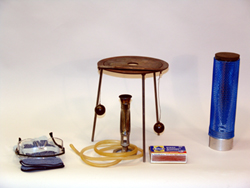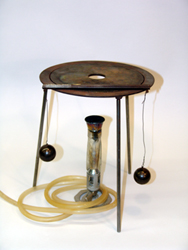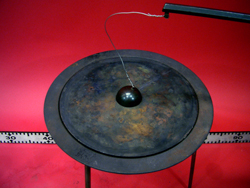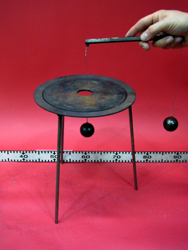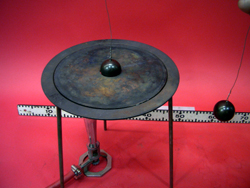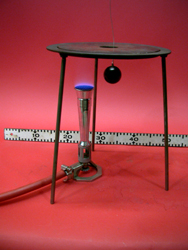|
Size: 1293
Comment:
|
Size: 4035
Comment:
|
| Deletions are marked like this. | Additions are marked like this. |
| Line 2: | Line 2: |
| = Balls and Plate , 4A30.21 = | ||<30% style="text-align:center">[[PiraScheme#Thermodynamics|Table of Thermodynamics Demonstration]] ||<30% style="text-align:center">[[TDEquipmentList|Thermodynamics Equipment List]] ||<30% style="text-align:center">[[Demonstrations|Lecture Demonstrations]] || = Balls and Plate , 4A30.22 = '''Topic and Concept:''' . Thermal Properties of Matter, [[ThermalProperties#SolidExpansion|4A30. Solid Expansion]] |
| Line 5: | Line 11: |
| * '''Cabinet:''' Thermodynamics Cabinet * '''Bay:''' (A3) * '''Shelf:''' #1 |
|
| Line 9: | Line 12: |
| (attachment photo showing the fully set up demonstration) | * '''Cabinet:''' [[ThermoCabinet|Thermodynamics (TD)]] * '''Bay:''' [[ThermoCabinetBayA3|(A3)]]? * '''Shelf:''' #1? |
| Line 11: | Line 16: |
| '''Description:''' | {{attachment:4A30-22_01.jpg}} |
| Line 13: | Line 18: |
| Insert description of apparatus, its component, what it is demonstrating. | '''Abstract:''' |
| Line 15: | Line 20: |
| ||<:style="width: 60%" :40%>'''Equipment'''||<:30%>'''Location'''||<:25%>'''ID Number'''|| | A plate with a hole is heated with a set of two balls, one over and one under size. Heat the plate and slip over both. ||<40% style="text-align:center">'''Equipment''' ||<30% style="text-align:center">'''Location''' ||<25% style="text-align:center">'''ID Number''' || |
| Line 17: | Line 23: |
| ||apparatus||ME, Bay B1, Shelf #2|| || ||all other parts||ME, Bay B1, Shelf #2|| || ||...||ME, Bay B1, Shelf #2|| || ||Possible supplies that are needed||Rode and Tack Cabinet|| || ||...|| In Lecture Halls|| || ||...|| Stock Cabinet || || ||...|| Stock Cabinet || || |
||A brass plate with a hole ||[[ThermoCabinetBayA3|TD, A3, Shelf #1]] ||<style="text-align:center">4A30.22 || ||Two metal balls attached to a rod ||[[ThermoCabinetBayA3|TD, A3, Shelf #1]] ||<style="text-align:center">4A30.22 || ||Burner ||location ||<style="text-align:center">NA || ||Liquid Nitrogen ||location ||<style="text-align:center">NA || ||Safety glove and glasses ||location ||<style="text-align:center">NA || ||[[RedWhiteGasCart|red and white gas carts]] ||Rooms 2103, 2241, (and 2223 upon request) || || |
| Line 25: | Line 30: |
| '''Setup:''' | |
| Line 27: | Line 31: |
| 1. Make a Setup check list. 1. ... |
'''''Important Setup Notes:''''' * This demonstration requires a supply of methane gas usually provided by the [[RedWhiteGasCart|red and white gas carts]] found in rooms 2103, 2241, (and 2223 upon request). '''Setup and Procedure:''' 1. Make sure you have the balls with two sizes, one is over and one is under the hole size, the brass plate with hole in the middle, and the stand. 1. Have the liquid nitrogen in the holder. Option A. Shrink or extended ball 1. Demonstrate to students that the smaller ball can get through the hole and the larger ball cannot. 1. Heat the smaller ball or put the larger ball in the liquid nitrogen, this will make the opposite situation from the previous. Option B. Extended Hole 1. Demonstrate to students that the smaller ball can get through the hole and the larger ball cannot. 1. Heat the ball by the burner until you sure that the hole get larger than before. 1. Demonstrate to students again, this time both balls should get through the hole. |
| Line 31: | Line 48: |
| 1. List any Warnings.... 1. Demonstration may require practice. |
* Beware of the heated plate - contact with skin could cause severe burns! '''Discussion:''' When the plate is heated, the dimensions of the plate increase while maintaining their relative proportions. In other words, the overall area of the plate expands along with the size of the hole while the ratio of hole area to plate area remains the same. The molecular bonds are lengthened, when the material expands. Try to think in this way, a group of people standing in a tight circle with elbows linked. Then they lengthen their "bonds" by moving to hold hands at arms length. They also have to expand the circle by standing back, while they all stand further apart. This is like the molecular bonds around the hole. So the ball can get through it. You have two options to show student by following. || {{attachment:4A30-22_01a.jpg}} || {{attachment:4A30-22_02a.jpg}} || {{attachment:BallsPlate03-250.jpg}} || {{attachment:BallsPlate04-250.jpg}} || || {{attachment:BallsPlate05-250.jpg}} || {{attachment:BallsPlate06-250.jpg}} || {{attachment:BallsPlate07-250.jpg}} || |
| Line 35: | Line 58: |
| '''Demonstration:''' | |
| Line 37: | Line 59: |
| Insert description of demonstration, how is the demonstration preformed. | |
| Line 39: | Line 60: |
| ||attachment other photos||attachment other photos|| ||attachment other photos||attachment other photos|| |
'''Videos:''' * [[https://www.youtube.com/user/LectureDemostrations/videos?view=1|Lecture Demonstration's Youtube Channel]] |
| Line 44: | Line 66: |
| 1. List any references | * [[https://en.wikipedia.org/wiki/Thermal_expansion|Wikipedia - Thermal Expansion]] * [[http://en.wikipedia.org/wiki/Coefficient_of_thermal_expansion|Wikipedia - Coefficient of Thermal Expansion]] |
| Line 46: | Line 69: |
| [Insert a back link to main topic list] [:Demonstrations:Demonstrations] [:Instructional:Home] |
[[Instructional|Home]] |
Balls and Plate , 4A30.22
Topic and Concept:
Thermal Properties of Matter, 4A30. Solid Expansion
Location:
Cabinet: Thermodynamics (TD)
Bay: (A3)?
Shelf: #1?
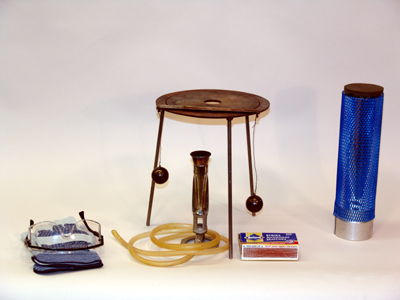
Abstract:
A plate with a hole is heated with a set of two balls, one over and one under size. Heat the plate and slip over both.
Equipment |
Location |
ID Number |
|
|
|
A brass plate with a hole |
4A30.22 |
|
Two metal balls attached to a rod |
4A30.22 |
|
Burner |
location |
NA |
Liquid Nitrogen |
location |
NA |
Safety glove and glasses |
location |
NA |
Rooms 2103, 2241, (and 2223 upon request) |
|
Important Setup Notes:
This demonstration requires a supply of methane gas usually provided by the red and white gas carts found in rooms 2103, 2241, (and 2223 upon request).
Setup and Procedure:
- Make sure you have the balls with two sizes, one is over and one is under the hole size, the brass plate with hole in the middle, and the stand.
- Have the liquid nitrogen in the holder. Option A. Shrink or extended ball
- Demonstrate to students that the smaller ball can get through the hole and the larger ball cannot.
- Heat the smaller ball or put the larger ball in the liquid nitrogen, this will make the opposite situation from the previous. Option B. Extended Hole
- Demonstrate to students that the smaller ball can get through the hole and the larger ball cannot.
- Heat the ball by the burner until you sure that the hole get larger than before.
- Demonstrate to students again, this time both balls should get through the hole.
Cautions, Warnings, or Safety Concerns:
- Beware of the heated plate - contact with skin could cause severe burns!
Discussion:
When the plate is heated, the dimensions of the plate increase while maintaining their relative proportions. In other words, the overall area of the plate expands along with the size of the hole while the ratio of hole area to plate area remains the same. The molecular bonds are lengthened, when the material expands. Try to think in this way, a group of people standing in a tight circle with elbows linked. Then they lengthen their "bonds" by moving to hold hands at arms length. They also have to expand the circle by standing back, while they all stand further apart. This is like the molecular bonds around the hole. So the ball can get through it. You have two options to show student by following.
|
|
|
|
|
|
|
Videos:
References:
